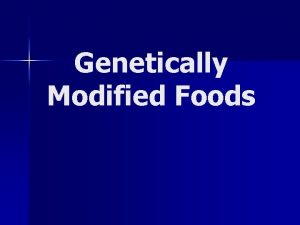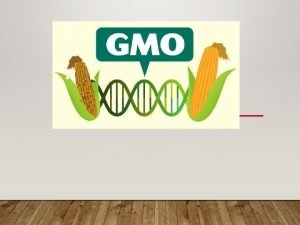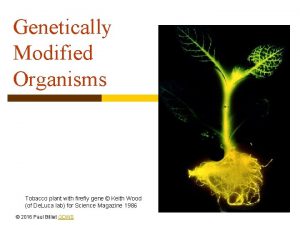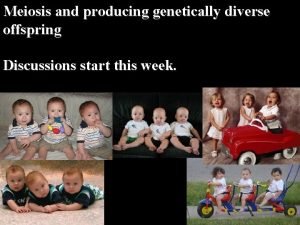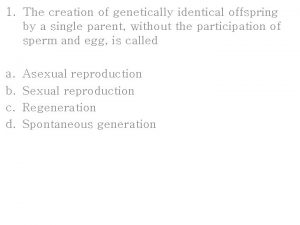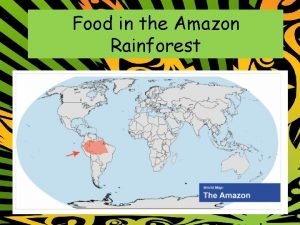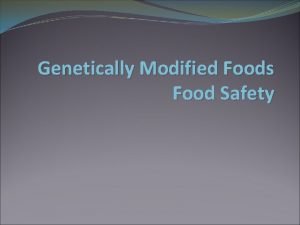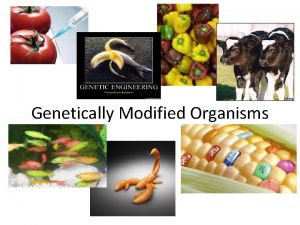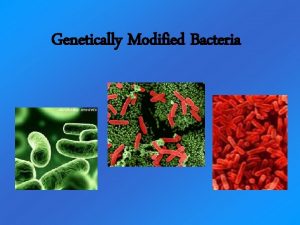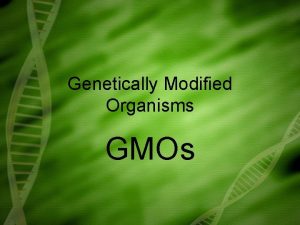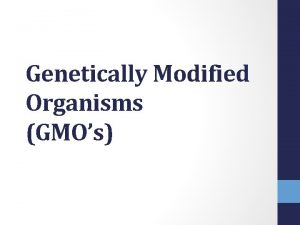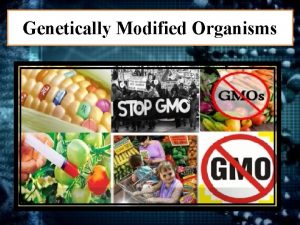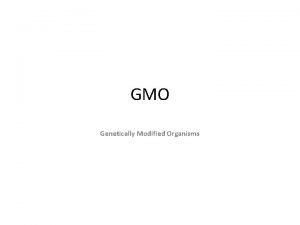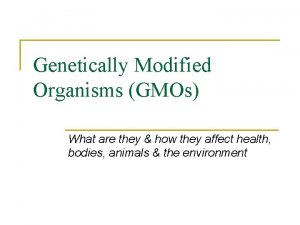Genetically Modified Food GMOs Are genetically modified foods






















- Slides: 22

Genetically Modified Food/ GMOs Are genetically modified foods beneficial?

Do Now: Think about what you eat on a daily basis. What do you typically eat? How do you decide what to eat? (cost, quality, etc. )

Tomatoes have gotten larger and ripen later due to genetic modification. Cattle has started to undergo genetic modification to produce more milk and meat products for consumption.

Farmers have been practicing selective breeding for centuries to increase output cows can now produce more milk, chickens can produce larger eggs, and grain is in larger abundance from wheat.

All of the following breeds of dogs were selectively bred from the same ancestor.

GMOS in major crops What could be some potential benefits/ harms to producing genetically modified foods? (think of all health and ethical modifications)

Timeline of Events 1935 – DNA Discovered: Russian scientist Andrei Nikolaevitch Belozersky isolates pure DNA. 1980 – First GMO Patent Issued: A 1980 court case between a genetics engineer at General Electric and the U. S. Patent Office is settled by a 5 -to-4 Supreme Court ruling, allowing for the first patent on a living organism. 1982 – FDA Approves First GMO: Humulin, insulin produced by genetically engineered E. coli bacteria, appears on the market. 1994 – GMO Hits Grocery Stores: The U. S. Food and Drug Administration approves the Flavr Savr tomato for sale on grocery store shelves. The delayed-ripening tomato has a longer shelf life than conventional tomatoes. 1996 – GMO-Resistant Weeds: Weeds resistant to glyphosate, a herbicide used with many GMO crops, are detected in Australia. Research shows that the superweeds are seven to 11 times more resistant to glyphosate than the standard susceptible population. 1999 – GMO Food Crops Dominate: Over 100 million acres worldwide are planted with genetically engineered seeds. The marketplace begins embracing GMO technology at an alarming rate. 2003 – GMO-Resistant Pests: In 2003, a Bt-toxin-resistant caterpillar-cum-moth, Helicoverpa zea, is found feasting on GMO Bt cotton crops in the southern United States. In less than a decade, the bugs have adapted to the genetically engineered toxin produced by the modified plants.



Major US crops that use GMOs - Alfalfa Canola Corn Cotton Papaya Soybean Sugar Beets Zucchini/ Summer Squash

Discuss in your groups! Why do certain countries use GMOs more than others? (Generate a list of potential reasons in your groups)

Monsanto Campaign Contributions from 1990 -2012 The “Big 6” companies, like Monsanto, donate heavily to political campaigns on both the federal and state level.

The major pesticide and GMO corporations are called the “BIG 6” because they have dominance over the agricultural market and own the world’s seed, pesticide and biotechnology industries.

In July 2016, the Obama Administration passed a GMO labeling bill that had bipartisan support. The Trump Administration (who has favored big business and corporations) has advocated deregulation.


Most researchers and scientists have deemed GMOs safe and that they do not pose any health risks to humans. Some believe that GMOs are responsible for certain food allergies, cancers, and damages to reproductive health (however those claims have been difficult to prove). “…the study committee found no substantiated evidence of a difference in risks to human health between currently commercialized genetically engineered (GE) crops and conventionally bred crops, nor did it find conclusive cause-and -effect evidence of environmental problems from the GE crops. ” - U. S. National Academy of Sciences, 2016


GMOs could benefit farmers who grow potatoes (and other crops) as climate change creates new challenges to grow certain crops.

Anti-GMO activist Vandana Shiva calls Monsanto’s Bt cotton seed (which is resistant to pesticide) the “seeds of suicide. ” - Bt cotton seeds require more water The farmers rely on rain and not irrigation pumps The crop yields were less than expected putting farmers into debt/ bankruptcy



DISCUSS! Let’s select teams for Friday’s debates and start formulating arguments/ picking specific speaking roles. Are genetically modified foods beneficial?
 Insidan region jh
Insidan region jh Genetically modified food
Genetically modified food Advantage of gmo
Advantage of gmo Hannah caesar
Hannah caesar Gmos
Gmos Genetically modified organisms
Genetically modified organisms Rdna technology applications
Rdna technology applications Genetically modified organisms
Genetically modified organisms Genetically modified crops have
Genetically modified crops have Kayla antoniou
Kayla antoniou Tobacco plant firefly gene
Tobacco plant firefly gene Genetically modified crops have
Genetically modified crops have Australian standards for texture modified foods and fluids
Australian standards for texture modified foods and fluids Unit 2 food food food
Unit 2 food food food Eltonian pyramid
Eltonian pyramid Diverse offspring
Diverse offspring The creation of genetically identical offspring
The creation of genetically identical offspring Chapter 22 genetics and genetically linked diseases
Chapter 22 genetics and genetically linked diseases Are fingerprints genetically inherited
Are fingerprints genetically inherited Wic cereal list
Wic cereal list Food in the amazon rainforest
Food in the amazon rainforest What's my favourite food
What's my favourite food Cariogenic foods
Cariogenic foods

